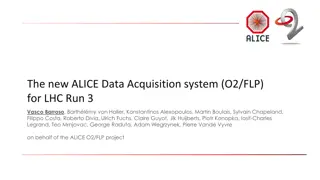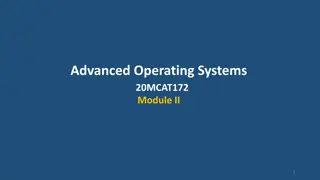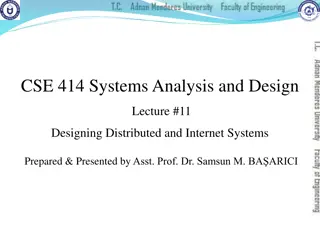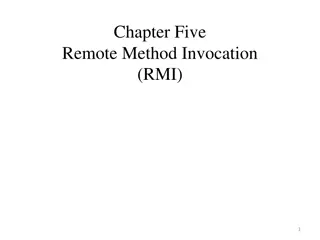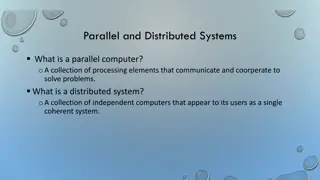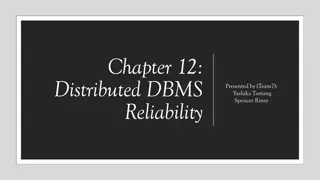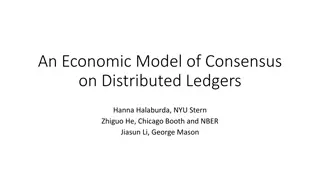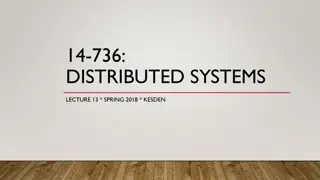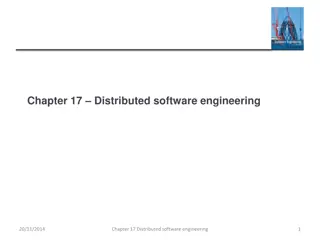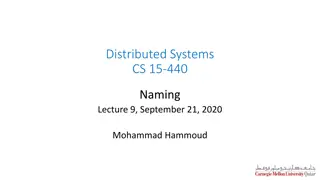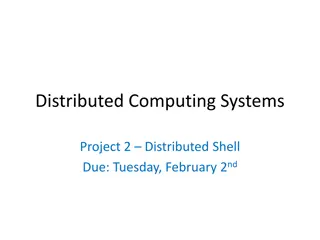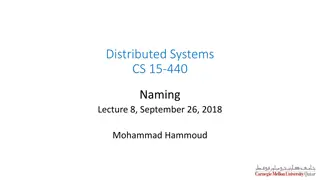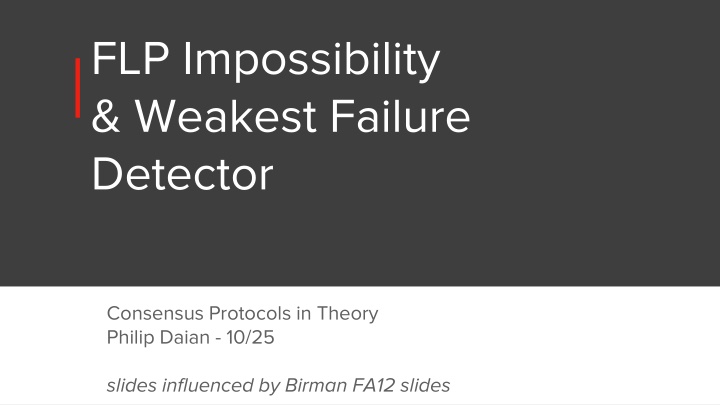
Distributed Consensus Protocols: Overview and Challenges
Explore the challenges and impossibility of achieving distributed consensus in theory, influenced by previous works, and its implications in various applications such as clock synchronization and load balancing.
Download Presentation

Please find below an Image/Link to download the presentation.
The content on the website is provided AS IS for your information and personal use only. It may not be sold, licensed, or shared on other websites without obtaining consent from the author. If you encounter any issues during the download, it is possible that the publisher has removed the file from their server.
You are allowed to download the files provided on this website for personal or commercial use, subject to the condition that they are used lawfully. All files are the property of their respective owners.
The content on the website is provided AS IS for your information and personal use only. It may not be sold, licensed, or shared on other websites without obtaining consent from the author.
E N D
Presentation Transcript
FLP Impossibility & Weakest Failure Detector Consensus Protocols in Theory Philip Daian - 10/25 slides influenced by Birman FA12 slides
Consensus! Courtesy of https://rethinkdb.com
Consensus Example Clients Storage Leader
Consensus Example 100101 - S3 100101 - S3 Clients Storage 100101 - S3 Replicated Leader 100101 - S3
Consensus Summary Important problem! We ve already talked quite a bit about forms of consensus State machine replication -> consensus on state of machine Leader election in leadered protocols -> consensus on leader Paxos, CORFU -> essentially consensus protocols Byzantine Generals -> consensus in malicious actor setting Applications: clock synchronization, PageRank, opinion formation, power smart grids, state estimation, control of UAVs, load balancing and so on (Wiki) Conditions: Termination Validity, Integrity, Agreement
Impossibility of Distributed Consensus with One Faulty Process 1985 2001 Dijkstra prize; best paper in distributed systems distributed systems, e-voting, oblivious transfer distributed algorithms and impossibility results, formal modeling algorithms, complexity, theory
FLP : Primary Result asynchronous deterministic distributed consensus impossible with even 1 crash failure
Follow along! http://the-paper-trail.org/blog/a-brief-tour-of-flp- impossibility/
message buffer Communication Model processes
message buffer send(p, m) (p, m) processes
message buffer (p, m) p processes receive(p)
message buffer reliable m p processes receive(p)
message buffer reliable Step - Part 1 : event m p processes receive(p)
message buffer reliable Step - Part 2 p processes
message buffer reliable Configuration ... p processes
Schedule - p0 v1 p1 v2 Event (receipt of m by p) Event (receipt of m by p) Event (receipt of m by p) p2 v3 p3 v4
Run run p0 v1 p1 v2 Event (receipt of m by p) Event (receipt of m by p) Event (receipt of m by p) p2 v3 p3 v4
0-Valent Configuration All Processes Decide 0 Schedule - 1 p0 v1 p1 v2 Schedule - 2 p2 v3 Schedule - 3 p3 v4
Initial configuration All Processes Decide 0 Schedule - 1 p0 v1 p1 v2 Schedule - 2 p2 v3 Schedule - 3 p3 v4
1-Valent Configuration All Processes Decide 1 Schedule - 1 p0 v1 p1 v2 Schedule - 2 p2 v3 Schedule - 3 p3 v4
Bivalent Configuration (Read: Undecided) Decide 0 Schedule - 1 p0 v1 Decide 1 Schedule - 2 p1 v2 Decide 0 Schedule - 3 p2 v3 Schedule - 4 p3 v4
Now, we prove: Any protocol in our model must have an infinitely long run (that never terminates)
Proof Outline Start from the initial guaranteed bivalent configuration (Lemma 2) Since the configuration is bivalent, there must be another bivalent configuration reachable from the configuration by applying e last (Lemma 3) Since the configuration is bivalent (Lemma 3) Bivalent Initial Configuration Event Event Bivalent Configuration Bivalent Configuration Infinitely (Lemma 3) (Lemma 3) Lemma 2
Lemma 1; Housekeeping Schedules are commutative
Lemma 2 There is an initial bivalent configuration (see: bivalent; read: undetermined / undecided)
Initial Configurations - neighbors 0-valent 1-valent p0 v1 v1 p1 v2 v2 p2 v3 v3
Initial Configurations 0-valent 1-valent p0 v1 v1 p1 v2 v2 p2 v3 v3
Initial Configurations 0-valent 1-valent p0 v1 v1 p1 v2 v2 p2 v3 v3
Initial Configurations 0-valent 1-valent p0 v1 v1 p1 v2 v2 p2 v3 v3 bivalent OR both 0 OR both 1
3 Processes - All Possible Inputs p0 0 1 1 0 0 1 1 0 p1 0 0 1 1 1 1 0 0 p2 0 0 0 0 1 1 1 1
3 Processes - Neighbors differ by 1 Process Input p0 0 1 1 0 0 1 1 0 p1 0 0 1 1 1 1 0 0 p2 0 0 0 0 1 1 1 1
We want to prove There is an initial bivalent configuration assume the opposite - All initial configurations univalent (see: bivalent; read: undetermined / undecided)
3 Processes - A Univalent-Only Scheme 1 0 1 0 1 0 1 0 p0 0 1 1 0 0 1 1 0 p1 0 0 1 1 1 1 0 0 p2 0 0 0 0 1 1 1 1
3 Processes - Another Univalent-Only Scheme 0 0 0 0 1 1 1 1 p0 0 1 1 0 0 1 1 0 p1 0 0 1 1 1 1 0 0 p2 0 0 0 0 1 1 1 1
So Univalent only schemes don t work Must have initial bivalent configuration!
Reminder Start from the initial guaranteed bivalent configuration (Lemma 2) Since the configuration is bivalent, there must be another bivalent configuration reachable from the configuration by applying e last (Lemma 3) Since the configuration is bivalent (Lemma 3) Bivalent Initial Configuration Event Event Bivalent Configuration Bivalent Configuration Infinitely (Lemma 3) (Lemma 3) Lemma 2
Lemma 3 If C is a bivalent configuration, and e is an event applicable to C, there is a bivalent configuration reachable by applying e last (this is the big one)
Lemma 3 2 Ingredients: An event, e (fix any event) D - all configurations right after e D Receive e Any Configuration New Configuration
Lemma 3 We will show: D has a bivalent configuration (through series of contradictions)
Lemma 3 - Contradiction 1 D has only 1-valent configurations (E0 has seen e) Receive e Initial C Bivalent E0 0 Valent
Lemma 3 - Contradiction 1 D has only 1-valent configurations (E0 has seen e) Just received e Other events D Initial C Bivalent F0 1 Valent? E0 0 Valent
Lemma 3 - Contradiction 1 D has only 1-valent configurations (E0 has seen e) Just received e Other events D Initial C Bivalent F0 1 Valent? E0 0 Valent
Lemma 3 - Contradiction 1 D has only 1-valent configurations (E0 has not seen e) Events (no e) Initial C Bivalent E0 0 Valent
Lemma 3 - Contradiction 1 D has only 1-valent configurations (E0 has not seen e) Events (no e) Initial C Bivalent E0 0 Valent D e F0 1 Valent?
Lemma 3 - Contradiction 1 D has only 1-valent configurations (E0 has not seen e) Events (no e) Initial C Bivalent E0 0 Valent D e F0 1 Valent?
Summary Disproven: D has only 1-valent configurations D has only 0-valent configurations (same) 2 Possibilities: D has only 1, 0 valent configurations (no bivalent) [next] D has bivalent configurations
Lemma 3 - Contradiction 1 D has only 1, 0-valent configurations D0 0 Valent D Initial C Bivalent D1 1 Valent
Lemma 3 - Contradiction 1 D has only 1, 0-valent configurations (e and e have different destinations) D0 0 Valent D Initial C Bivalent C0 1 Valent D1 1 Valent
Lemma 3 - Contradiction 1 D has only 1, 0-valent configurations (e and e have different destinations) D0 0 Valent D Initial C Bivalent C0 1 Valent D1 1 Valent

